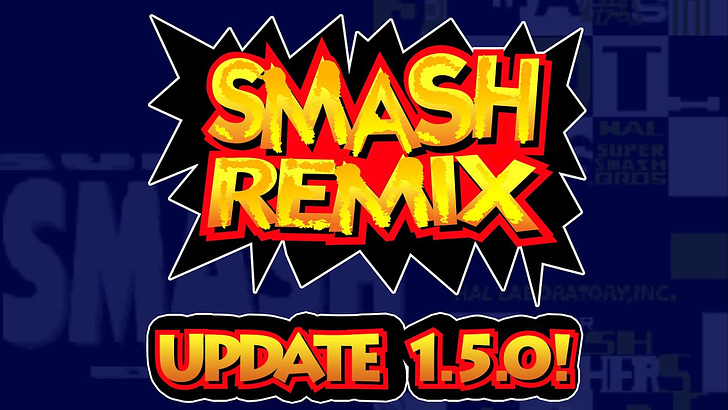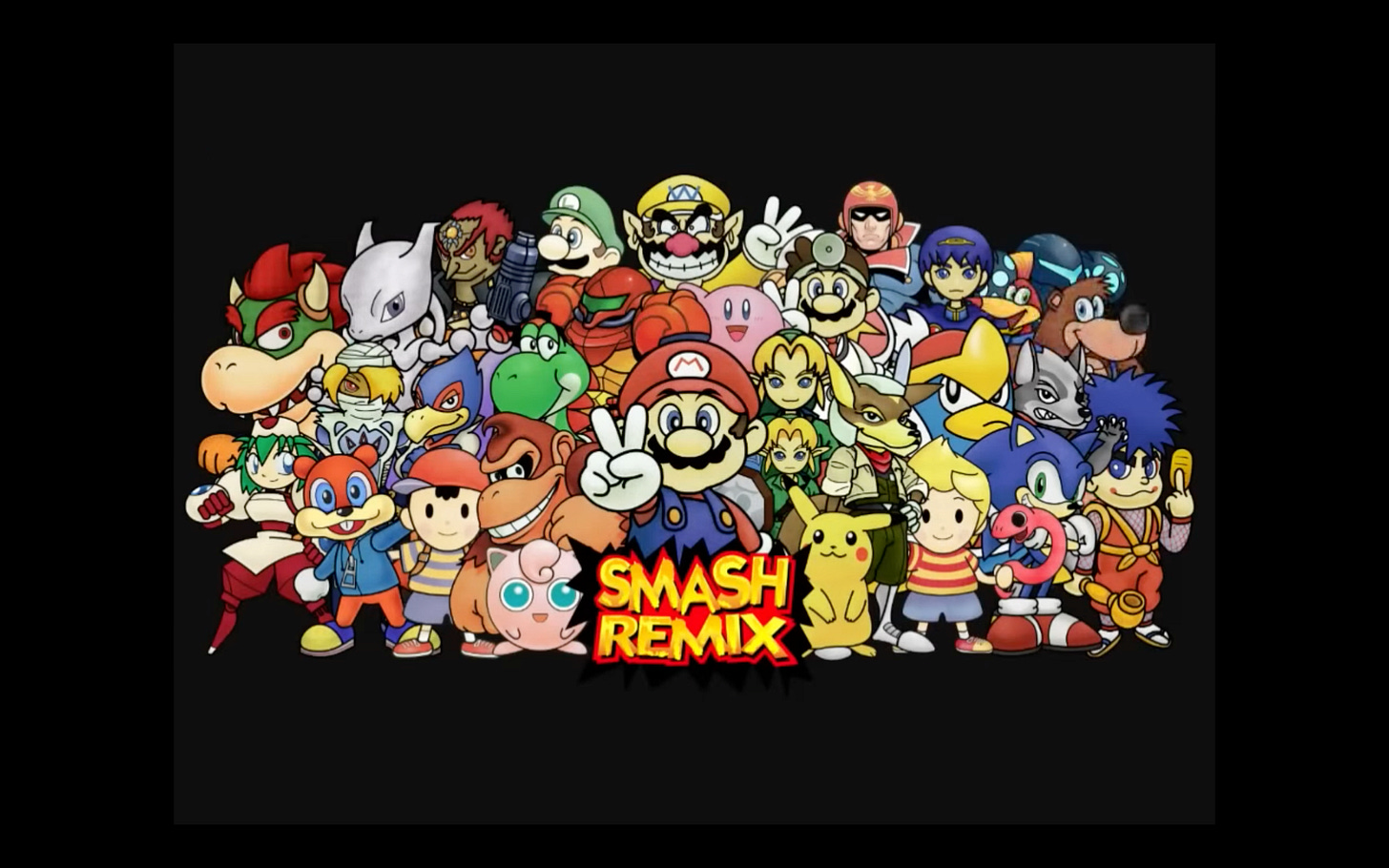There is no shortage of Smash Bros fan games and mods, it’s a series that has inspired countless people to get creative. For this post I want to talk about a mod that went back to the original game on the Nintendo 64 and created a new spin on it, Smash Remix.
Smash Remix takes everything in the original Smash Bros and adds to it, with new characters, stages, modes, and more. It’s still being developed, but from my understanding the roster is at least finalized now as of version 1.5.0. And either way, there’s plenty in here worth discussing and highlighting.
Roster
One of the most obvious draws of Remix over the original is the much larger character roster, and while it mostly consists of characters backported from later games in the series, there are also some fully original ones.
The new characters who haven’t appeared in an official Smash Bros game are Conker the Squirrel (Conker’s Bad Fur Day), Goemon (Mystical Ninja), and Marina Liteyears (Mischief Makers). I like that this actually has characters I’m unfamiliar with. Not enough people appreciate the out there and deep cut picks in Smash Bros. Trying them out was fun with the added surprise factor of not knowing what to expect.
Backported from later entires in the series we have Falco, Young Link, Doctor Mario, Bowser, Ganondorf, Marth, Wario, Sonic, King Dedede, Lucas, Wolf, Dark Samus, and Banjo & Kazooie. Since the original Smash Bros only had three specials compared to later games four, all have had to adjust to the older way of doing things, with some characters like Wario getting changes that go well beyond that.
My usual pick, Falco, has traded his blaster for the dashing attack that in later games is his side special. Personally I wish they let Falco have the Brawl onwards version of his down b. With the removal of his blaster it would have been interesting to have the reflector as his only projectile, but in Smash Remix it works the same way as Fox’s.
There’s also more to the roster than what you’ll see at a glance of the character select screen. Each character has alternate costumes, and some of these are actually just different characters, complete with new moves, but not all are balanced and they don’t have their own bonus mode stages like full characters.
Expanding to bonus characters, with the character they’re a ‘costume’ of in parentheses, the roster features Peppy (Fox), Slippy (Falco), Ebisumaru (Goemon), Mad Piano (Kirby), Super Sonic (Sonic), Giga Bowser (Bowser), Giant Donkey Kong (Donkey Kong) and Dragon King (Captain Falcon). That last one is based on the placeholder models from the earliest shown footage of Smash Bros before it became the Nintendo crossover fighter.
I dislike when some people act like every single aspect of the Mario franchise needs a dedicated character on the Smash Bros roster, but that haunted piano from Mario 64 is such an out there pick that I have to respect it. It’s a far more interesting choice than ‘the other Mario character who exists to pad out rosters’ or ‘literally just Mario in a different art style.’
As a long time Falco main Peppy and Slippy are the most interesting of the bonuses to me, I’d call the idea of adding them to the roster excessive in most circumstances, but both of them build off the base Star Fox moveset in their own way that is interesting to see. Each has distinct blaster specials, with Peppy charging up his so he can fire a burst of three shots later while Slippy pulls out a sniper rifle that takes time to fire, and Peppy swaps out the reflector for a bomb that stuns opponents hit by it.
A touch I appreciate that’s technically outside of the mod is the trailers for each new release, which give new fighters the same sort of trailers they’d get in an official release, and theme the rundown of other new features after a relevant game, like Banjo-Kazooie in the most recent one.
Stages
Like with the roster, Smash Remix’s added stages consist of both simplified backports and genuine new additions, sometimes with multiple put in the same spot as variations of each other. Smash Remix has Temple so that automatically gives it a passing grade, and the new stages are creative and draw from a diversity of games.
The amount of stages in itself is impressive, with several pages to flip through on the select screen and many having multiple versions to choose from. Though this can make finding the one you want to play on a bit difficult at times.
Confusingly there are stages that share a name with official game stages but have a different layout. Smash Remix Gerudo Valley and the Gerudo Valley stage introduced in the 3DS Smash Bros are completely different stages despite being modeled after the same location and having the same name.
For some stages I had no idea what game they were from until I saw the music name that included the name of the source game. There’s a good variety of games taken from here, ranging from Doom to Wave Race to Quest 64 of all things. Like with the brand new characters I enjoyed the surprise of trying out a new stage not even sure what game it represented.
More importantly, the stages have actually varied geometry and hazards. Not all of them feel equal, but the ones that work feel on par with the official games.
Scuttle Town is currently my favorite stage in the game despite being sick of Shantae content in Smash fandom, it’s a hazardless stage that manages to be interesting with its layout alone.
For other stages Pirate Land is delightfully chaotic with a cannon in the background that fires on the stage, you need to keep an eye on it as you fight. Meanwhile Spawned Fear may be a tad too gimmicky at times, but I appreciate that it’s doing something unique with its poison floor and how the layout with the near omnipresent ceiling works with it.
Twilight City and Jack Bros (based on the game of the same name) are solid stages I mainly appreciate for the games they represent. I think a Wave Race stage like Twilight City is a smart inclusion for a Smash Bros game and Jack Bros is the first time I’ve seen a Smash Bros stage based off a Virtual Boy game specifically even amongst other mods or fan games I’ve played.
As for specific stages that I feel miss the mark, Osohe Castle and Deku Tree both felt clunky. Osohe Castle feels too big for a stage with indestructible walls that block most horizontal KOs, like a worse Shadow Moses Island. Deku Tree is much smaller yet also has some geometry that feels clunky and artificially extends fights.
There’s quite a few stages that could be summed up as ‘Battlefield/Dreamland with a different arrangement and/or number of platforms and no hazards,’ which is a design approach I am sick of in the platform fighter genre as a whole. At least the Dreamland and Final Destination variants of stages are honest about what they are.
Lastly when it comes to variant stages I want to point out for the Castlevania fans that the Dracula’s Castle stage (different from its counterpart in Ultimate) has an inverted form.
Modes and more
There are new modes to try alongside the new characters and stages. Stamina mode is among the many backported features that functions as it does in later games. There’s also a 12 man Smash mode, where two teams of twelve characters take each other on one at a time until one team is eliminated.
Moving to the single player content there have been plenty of additions there as well. Every new character with their own slot has a board the platforms and break the targets stage. It’s possible to play any board the platforms or break the targets stage with any character, but that doesn’t mean they can clear it.
Race to the finish is available as its own bonus mode now, where you can challenge the original or a new harder version made for this mod. Classic mode has the same choice between the original or a new remix version. Naturally selecting remix will highlight all the new aspects of the mod, complete with a new final boss to confront.
All Star Mode and Multi Man Smash have been backported as well. All Star mode is surprisingly different from how it is in most games, mainly in that it starts you with 1v1 battles before eventually expanding as you go further down the roster. Like in later games there’s a resting area between battles, with access to healing items you’ll need to think carefully about when to use.
Multi Man Smash unfortunately is distinguished here by a comparative lack of features, there’s no 100 man Smash or 15 Minute Smash, just an endless mode and Cruel Smash. I only really played Multi Man for the unlocks in official titles so it’s not a big issue for me personally, but it did stand out when I noticed.
New items have also been added in Remix, with the same combination of backports and originals as other aspects. One of the new items is the golden gun from GoldenEye 007. You can also turn off specific Pokémon to keep them from appearing when you use a Pokéball item.
Other options offer more extensive changes to the game, like modifying the physics to resemble other games in the series. Some aspects of the original differed between regions, now you can adjust those traits freely. I personally appreciated the automatic z cancel feature, if you don’t know what I’m talking about it, you need to turn it on.
For fans of Smash Bros, especially ones who find the original rather sparse and outdated/outclassed compared to its follow ups, I definitely suggest you give this mod a try.
Also there’s a mod for this mod that adds Spider-Man.



